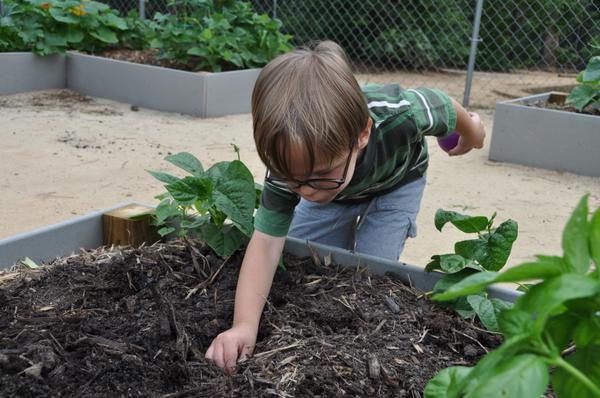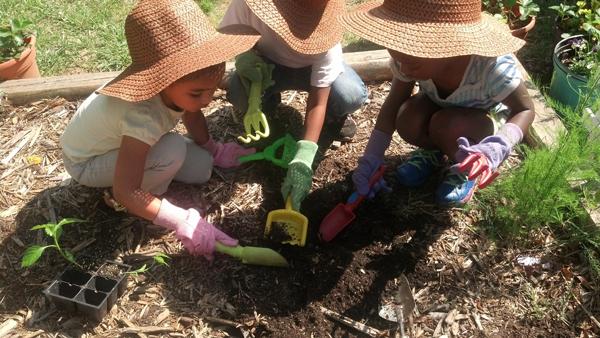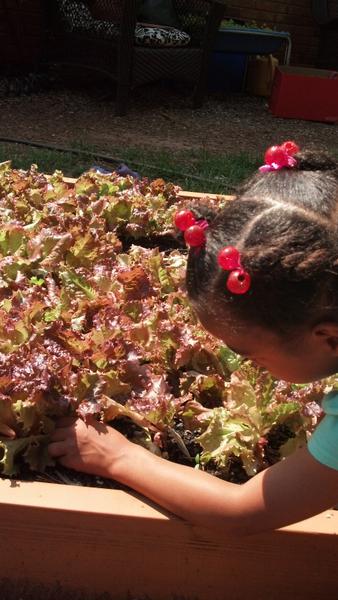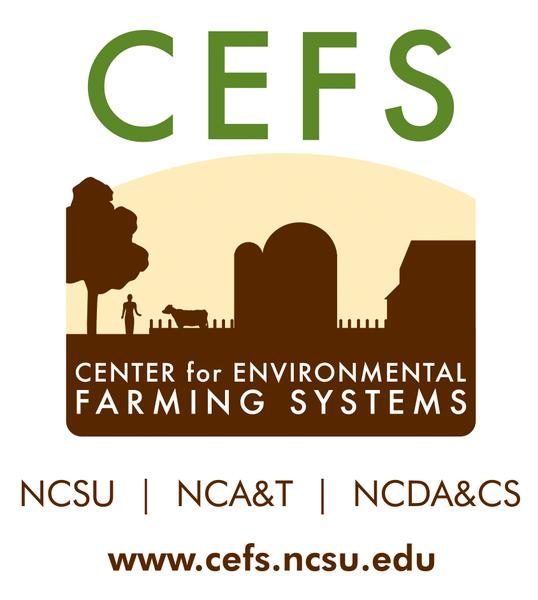This publication summarizes the benefits of fruit and vegetable gardening with children. It includes age-appropriate activities for childcare providers to engage young children in using fresh produce from a production garden for cooking and eating. This is the first of fifteen publications about childcare center production gardens.
Early childhood educators have an important opportunity to help create positive environments that connect with young children’s senses, allowing them to plant, grow, harvest, and ultimately prepare healthy eating experiences. Children develop healthy eating habits and preferences at an early age. The more engaged children become with hands-on food education, such as gardening and food preparation, the more likely they will prefer and routinely consume fruits and vegetables.1, 2, 3, 4
Findings of the Natural Learning Initiative (NLI) Preventing Obesity by Design (POD) program emphasize the significance of gardening for engaging teachers and children in on-site food production.5 By incorporating a designated production garden in the outdoor learning environment, childcare centers can inspire lifelong healthy eating habits and can become models for the families they serve.
The Centers for Disease Control and Prevention (CDC) recommend a diet high in fruits and vegetables to lower risk for numerous chronic illnesses, including cancer and cardiovascular disease.6 For most Americans two years and older, specifically preschool age children, vegetable intake falls below CDC recommendations.7, 8 Natural Learning Initiative (NLI) Preventing Obesity by Design (POD) childcare centers recognize that a well-balanced eating plan containing fruits and vegetables can help children maintain a healthy weight.9 These centers have embraced and integrated growing, harvesting, and cooking with children into their daily curriculums.
Why is exposure to growing and cooking fruits and vegetables important for young children?
- Dietary Guidelines for Americans recommend at least two servings of both fruits and vegetables each day.
- Essential vitamins, minerals, and fiber provided by fruits and vegetables may help prevent chronic diseases.
- Growing, preparing, and eating fruits and vegetables, from their own gardening efforts, can help children develop lifelong healthy eating habits.
- Participating in a full range of gardening from seed to tummy helps children understand the origins of food.
Gardening and Cooking Abilities of Young Children
Classroom activities based on experiences with growing and cooking fruits and vegetables can help young children learn key developmental skills10, including:
- Science skills: classification, weather, insects, soil, and plant life cycles.
- Math skills: counting, measuring, and weighing.
- Language skills: describing and comparing color, taste, and texture.
- Fine motor skills: mixing, spreading, and chopping.
- Cognitive skills: curiosity, cause-and-effect, and problem-solving.
Young children are curious and highly motivated to learn new skills like gardening and cooking. With adult encouragement in a safe, carefully prepared, and supervised environment, growing and cooking abilities can advance rapidly, aligned with age-appropriate activities:
Appropriate activities for two-year-olds include:
Gardening
- pushing child-size wheelbarrows
- watering plants with help from a teacher
- pushing large seeds, such as beans and peas, into the soil
- observing insects and ripening produce
Cooking
- scrubbing vegetables and fruits
- carrying (unbreakable) items to the table
- dipping foods
- washing and tearing lettuce and salad greens
- breaking bread into pieces
Appropriate activities for three-year-olds include:
Gardening
- mixing soil to prepare garden beds
- planting large seeds and seedlings
- filling up watering cans
- watering plants
- pulling weeds
- observing plant growth
- comparing leaf shapes
- describing appearance of fruits and vegetables
Cooking
- pouring liquids into batter (measured first)
- mixing batter or other dry and wet ingredients together
- shaking a drink in a closed container
- spreading butters or other spreads
- kneading dough
- washing vegetables and fruit
- serving foods
- placing things in the trash after cooking or after a meal
Appropriate activities for four- and five-year-olds include:
Gardening
- shoveling compost and mulch
- raking soil to prepare garden beds
- planting small seeds and seedlings
- harvesting ripe produce
- training and weaving vines onto a trellis or fence
- collecting seeds
- filling up watering cans
- watering plants
- pulling weeds
- identifying garden insects
- weighing produce
- comparing shapes and sizes of produce
- observing insects and birds
- drawing garden scenes or items
Cooking
- juicing oranges, lemons, and limes
- peeling some fruits and vegetables (bananas and even onions)
- mashing soft fruits and vegetables
- scrubbing vegetables (potatoes, mushrooms)
- cutting soft foods with a plastic knife (mushrooms, hard-boiled eggs)
- pressing cookie cutters
- measuring dry ingredients
- cracking and breaking open eggs
- beating eggs with an egg beater
- stirring ingredients together
- setting the table
- wiping up after cooking
- clearing the table after a meal
Utensils required:
- Plastic cutting board
- Plastic knives for cutting
- Plastic measuring cups
- Stainless-steel or plastic bowls for mixing
- Plastic or wooden spoons for mixing
Tips for Engaging Kids in Cooking
(Also see publications LF-007-05 and LF-007-06 in this series.)
- Create a fun and nurturing environment where children have many opportunities to see, touch, smell, and taste the fruits and vegetables they have grown in the garden.
- Focus on seasonal fruits and vegetables being harvested from the garden, those available locally in season, or both. (Also see publications LF-007-03 and LF-007-04 in this series.)
- Model tasting new foods. Children are likely to follow an adult example.
- Encourage children to taste the raw product first, then to taste the cooked product, reminding children it may take multiple tastings to get used to new foods.
- Encourage young children to say “no thank you” when they do not like a new food, rather than “yucky” or another negative word. “Don’t yuck my yum!”
- Supplement harvest from the garden with items from the local farmers’ market when there is not enough for everyone to enjoy from the on-site garden.
- Make enthusiastic and positive comments about the taste and texture of the new food.
- Compliment and thank children for their care and attention in preparing the delicious food items.
- Lead a positive discussion about the food, including its taste, texture, smell, and color. Discuss how the food was prepared. Ask the children about the ingredients, the recipe, steps taken, and utensils used.
- Discuss appropriate serving sizes, which are smaller than for adults.11
Read children’s books that include cooking and gardening activities that can be referenced in the classroom (see below).
Children’s books about gardening and cooking:
Muncha! Muncha! Muncha! by Candace Fleming, Atheneum Books for Young Readers, 2002
Plant a Little Seed by Bonnie Flemming, Roaring Book Press, 2012
Two Old Potatoes and Me by John Coy, Nodin Press, 2013
Growing Vegetable Soup by Lois Ehlert, HMH Books for Young Readers, 1987
How Groundhog’s Garden Grew by Lynne Cherry, Blue Sky Press, 2003
Garbage Helps Our Garden Grow: A Compost Story by Linda Glaser, Millbrook Press, 2010
Grow It Cook It: Simple Gardening Projects and Delicious Recipes, DK Publishing, 2008
Rainbow Stew, by Cathryn Fallwell, Lee & Low Books, 2013
Child and Adult Care Food Program (CACFP) and local food
If your childcare program participates in the Child and Adult Care Food Program (CACFP), you can use the funds for things like purchasing food from farmers’ markets and planting edible gardens. Costs associated with growing food to be used in the meal service are allowable. These costs include such items as seeds, fertilizer, labor, and plot rental. See CACFP Financial Management Guide.12Safety Precautions
Take special care with food safety.13 As immune systems are still developing, children are more susceptible to foodborne illnesses than healthy adults. Establish a rule that children thoroughly wash their hands after gardening, after using the toilet, before and after handling food, and whenever hands get dirty. Teach the following hand-washing protocol:
- Wet hands with clean running water (warm or cold) and apply soap.
- Rub hands together to make lather and wash them well, including backs of hands, between fingers, and under nails.
- Rinse hands well under running water.
- Dry hands using a single-use towel.
References
1 Birch, L.L., McPhee, L., Shoba, B.C., Pirok, E., Steinberg, L. (1987). What kind of exposure reduces children's food neophobia? Looking vs. tasting. Appetite 9:171–178. ↲
2 Hermann, J.R., Parker, S.P., Brown, B.J., Siewe, Y.J., Denney, B.A., Walker, S.J. (2006). After-school gardening improves children’s reported vegetable intake and physical activity. J. Nutr. Educ. Behav. 38: 201–202. ↲
3 Langellotto, G.A., Gupta, A. (2012, August). Gardening increases vegetable consumption in school-aged children: A meta-analytical synthesis. HortTechnology 22(4): 430–445. ↲
4 Lineberger, S.E., Zajicek, J.M. (2000). Can a hands-on teaching tool affect student’s attitudes and behaviors regarding fruit and vegetables? HortTechnology 10:593–597. ↲
5 Moore, R.C., Cosco, N. (2014). Growing up green: Naturalization as a health promotion strategy in early childhood outdoor learning environments. Children, Youth and Environments 24(2): 168-191. ↲
6 Centers for Disease Control and Prevention. (2008). Improve your health while enjoying the season’s colorful produce. Atlanta, GA: CDC. ↲
7 U.S. Dept. of Agriculture, U.S. Dept. of Health and Human Services. (2010). Dietary guidelines for Americans. 7th ed. Washington, DC: US Govt. Printing Office. ↲
8 Enns, C.W., Mickle, S.J., Goldman, J.D. (2002). Trends in food and nutrient intake by children in the United States. Family Economics and Nutrition Review 14 (2): 56–69. ↲
9 Centers for Disease Control and Prevention. (2012). How to use fruits and vegetables to help manage your weight. Atlanta, GA: CDC. ↲
10 California Dept. of Public Health, Women, Infants and Children Program. (2015). Cooking abilities of young children. Sacramento: State of California. ↲
11 Hayes, D. (2014, Feb. 4). Step-wise nutrition for young children. Chicago, IL: Academy of Nutrition and Dietetics. ↲
12 US Dept. of Agriculture—Food and Nutrition Service. Financial Management: Child and Adult Care Food Program. Gardens and nutrition education (p. 111). Procurement (p. 152). Alexandria, VA: USDA. ↲
13 Chaifetz, A., Driscoll, L., Gunter, C., Ducharme, D., Chapman, B. 2012. Food safety for school and community gardens. A handbook for beginning + veteran garden organizers: Reducing food safety risks. Raleigh: N.C. Cooperative Extension, NC State University. ↲
Local Foods Publication Series Editor
Hannah Dankbar, Manager
Local Foods Program
NC State Extension
Childcare Center Production Gardens Publication Editors
Robin C. Moore, Director
Natural Learning Initiative (NLI)
NC State College of Design
with the NLI Early Childhood Gardening Team:
Nilda Cosco
Sarah Konradi
Mary Archer
Caroline Asher
Karli Stephenson, Graphic Designer
Acknowledgments
Funding for this publication was provided in part by the John Rex Endowment.
The authors wish to express appreciation to J. Dara Bloom, Nichole Huff, Susan Jakes, Joanna Lelekacs, Lynn Policastro, Debra Ireland, and Barbara Scott for their assistance in preparing this publication.
About the Local Foods Series: Childcare Center Production Gardens
This publication in the Local Foods series is the first of fifteen publications about childcare center production gardens:
- Growing and Cooking Fruits and Vegetables at Childcare Centers (LF-007-01)
- Creating Childcare Center Production Gardens (LF-007-02)
- Growing Warm-Season Fruits and Vegetables in Childcare Production Gardens (LF-007-03)
- Growing Cool-Season Vegetables in Childcare Production Gardens (LF-007-04)
- Snacking and Cooking with Warm-Season Produce from Childcare Production Gardens (LF-007-05)
- Snacking and Cooking with Cool-Season Produce from Childcare Production Gardens (LF-007-06)
- Composting in Childcare Center Production Gardens (LF-007-07)
- Vermicomposting in the Childcare Center Production Gardens (LF-007-08)
- Introducing Children to Insects in Childcare Center Gardens (LF-007-09)
- Easy Fruits to Grow at Childcare Center Gardens (LF-007-10)
- Growing Strawberries in Childcare Center Gardens (LF-007-11)
- Managing Weeds in Childcare Center Gardens (LF-007-12)
- Growing Fruit Trees in Childcare Center Gardens (LF-007-13)
- Growing Muscadines in Childcare Center Gardens (LF-007-14)
- Growing Blueberries in Childcare Center Gardens (LF-007-15)
Publication date: Sept. 16, 2015
Reviewed/Revised: Sept. 22, 2023
LF-007-01
N.C. Cooperative Extension prohibits discrimination and harassment regardless of age, color, disability, family and marital status, gender identity, national origin, political beliefs, race, religion, sex (including pregnancy), sexual orientation and veteran status.






